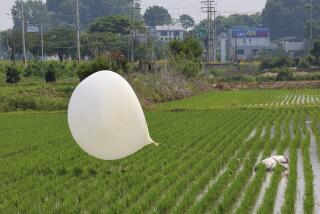Kids Crusade Against a Ballooning Problem
- Share via
BOSTON — Kids and balloons go together like peanut butter and jelly, right? For years, mass balloon launches have served as a crowd-pleasing, exhilarating way to celebrate a special event. Children stare up from the ground, focused on the soaring mass of color as it spreads and finally disappears.
But some kids are learning that balloons don’t just go away once they’re out of sight. In several states, schoolchildren have lobbied against balloon launches. They are concerned aboutpossible dangers to marine animals and the environment.
“Balloons do in fact come down again. They don’t go to heaven,” says Robert Schoelkopf, founder of the Marine Mammal Stranding Center in Brigantine, N.J.
Once a released balloon is about five miles up in the sky, it explodes into shreds and falls back to land or sea. In several cases, balloons or balloon fragments have been found in the stomachs of marine animals washed up dead on the shore. An ingested balloon or collected pieces can block the digestive system of a turtle or whale and cause starvation, Schoelkopf says.
Although there is no conclusive evidence that animals are dying directly because of ingesting balloons, a campaign started in 1987 has convinced many children that balloon launches are a threat to animals.
A children’s crusade of sorts has helped push through legislation banning or restricting the release of balloons in Florida, Connecticut and Texas. Several cities also have ordinances against balloon launches.
Many groups are canceling balloon releases in response to the environmental concern. Walt Disney World and Disneyland no longer color the skies above their theme parks with balloons. The Super Bowl and other football games are carrying on without a balloon launch at halftime.
The balloon industry views the controversy as a lot of hot air, and executives like Philip Levin, president of Balloon City U.S.A. in Harrisburg, Pa., are fighting back. To protest a bill against balloon releases in Pennsylvania, Levin released balloons daily from the Statehouse steps.
Levin has produced an eight-page comic book featuring Lex Latex, a talking balloon. “We’re natural and nontoxic,” explains Lex. “We latex balloons bring happiness and beauty to the world. We don’t harm it.” The comic book includes three experiments that kids can conduct at home to prove the biodegradable nature of latex balloons, Levin says.
The environmentalists are “destroying an entire generation of balloon buyers,” claims Levin.
“We have no problems with balloons,” says Susan Hibbard, a science teacher from Toms River, N.J., who founded the Balloon Alert Project in 1987. “As long as you don’t let them go in the environment, they’re wonderful.”
The Balloon Alert Project came about after Hibbard and her science-teacher husband, Peter, discovered a latex balloon in the digestive system of a leatherback sea turtle, an endangered species, found dead on the New Jersey shore.
Concluding that the turtle died of starvation, the Hibbards founded the Balloon Alert Project to inform other teachers and students of their concern about the environmental effects of balloon releases.
“There is absolutely no scientific evidence that balloons kill sea life,” Levin says. He attributes the turtle’s death to damage from a boat’s propeller blade.
In a study funded by the balloon and toy industries, Peter Lutz, a biologist at the University of Miami, fed shreds of balloons to sea turtles. Lutz says: “Swallowing these smaller pieces does disturb the turtle’s digestion and can cause ill effects.”
But Lutz is more concerned with the issue of littering in general. “The ocean is a big place,” he says, “and I don’t believe balloons are as important, in perspective, as plastic littering.”
Hibbard agrees: “It goes much further than balloons.”
More to Read
Sign up for Essential California
The most important California stories and recommendations in your inbox every morning.
You may occasionally receive promotional content from the Los Angeles Times.










